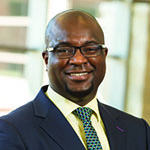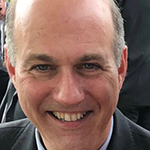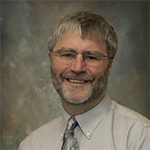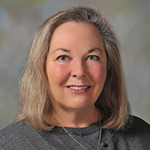By JULIE MINDA
April 8, 2020
As the number of COVID-19 cases rise in communities — and concurrently in health care facilities — across the U.S., the practice environment is changing dramatically for clinicians of every stripe. For palliative care specialists, the time and resource constraints that are becoming the norm in many facilities are forcing dramatic shifts in how they tend to patients and families and how they support colleagues.

Dr. Adeboye
During a series of weekly webinars, the Supportive Care Coalition and CHA are providing experts to help palliative care specialists to navigate the changes. During an April 2 webinar — the second in the series — Dr. Olumuyiwa Adeboye, medical director of palliative care for Ascension Wisconsin, said, "We must work in different ways, we must realize we're not alone, and we must be creative and innovative with workarounds" when unable to practice in the traditional way.

Kane
Joining Adeboye on the question-and-answer formatted panel were Brian M. Kane, CHA senior director of ethics; MC Sullivan, chief health care ethicist for the Initiative on Palliative Care and Advance Care Planning for the Archdiocese of Boston; and Dr. Gregg VandeKieft, medical director for palliative care for Providence St. Joseph Health's Southwest Region. The webinar, "Palliative Care and COVID-19: Implications for Clinical Practice Part Two," is available for replay at supportivecarecoalition.org/. CHA and the coalition are hosting webinars at 10 am eastern on April 9, April 16 and April 23. To register for a new webinar, or to watch a recording of a past webinar, visit supportivecarecoalition.org/, and click on the COVID-19 resources link at the very top of the page.

VandeKieft
During the April 2 webinar, the panelists fielded questions that had been posed in a chat format by participants in the first webinar in the series. The questions referenced the workload stress, the pressure some palliative care specialists are receiving to redeploy to new roles and the implicit bias some of them are confronting among colleagues making decisions about the allocation of scarce resources.

Sullivan
Empathy overload
The first question the panel fielded was from a palliative care specialist who expressed a sense of duty to serve patients but who nevertheless fears being infected. There has been concern in the field that new protocols for delivering palliative care — which can include remote contact with a patient via phone or video — may dilute the element of human compassion in palliative care. Those who are at the bedside easing the anxiety and pain of patients who will die from COVID-19, wear personal protective gear that covers much of their face and body.

Hibner
Sullivan said palliative care specialists are trained to provide in-person, high-touch, time-intensive, personalized care to patients, but that is not practical given the realities of the COVID-19 pandemic.
Palliative care specialists are feeling what she called "morale distress" — as opposed to moral distress — because they do not have the time or resources to deliver this type of care, and their potential exposure to contagion that accompanies face-to-face care could put them and their families at risk.
VandeKieft added that many practitioners are lamenting the distance that must exist now between them and patients. And many cannot emotionally process all of the traumatic situations they are encountering, and so there is cumulative distress over time.
Kane said to build resilience, palliative care specialists and their clinician colleagues can use "resiliency rounds," in which they pause to acknowledge the struggle they are facing and to briefly discuss it. Even if there is no quick way to resolve the struggle, naming it can be therapeutic.
Adeboye agreed it can be helpful to verbally acknowledge — including to patients — that this is not the usual way of delivering care, and that everyone is feeling fearful and unsettled. This can be a way to connect relationally, he said.
VandeKieft said palliative care practitioners can be creative in how they use technology to maintain high-quality care, despite the significant restrictions. He said he's largely using phone calls and videoconferencing for consults and has been pleasantly surprised that he can still have the same in-depth, effective conversations remotely that he formerly had in-person.
Redeployment
The second question for panelists was from a solo palliative care practitioner being redeployed away from practicing palliative care amid the crisis. The person worried about the loss of palliative care services for patients.
Adeboye said the quandary underscores the need for palliative care leadership to "be at the table" of organizational planning and response ahead of the COVID-19 wave, to emphasize the critical role palliative care can and should play, particularly in an epidemic.
Said Sullivan, when a palliative care practitioner is asked to "put on another hat," out of necessity, he or she may need to work smarter and more efficiently to cover the new role and also still influence the delivery of palliative care.
VandeKieft said that palliative care is a shared responsibility among a facility's clinical staff and so palliative care practitioners should be educating their colleagues on palliative care delivery so that if and when the specialists are redeployed, other staff still will be delivering such care.
He said also, if redeployed or stretched into other roles, palliative care specialists can use workarounds to still offer their expertise, if on a much more limited basis than usual. For instance, they can use "curbside consults" or very abbreviated conversations in place of in-depth consults, or "one-off" consults, in which they would not follow up as thoroughly after a consult as they normally would.
Implicit bias
The final question came from a palliative care provider who suspected that implicit bias of some colleagues was impacting the treatments offered to the elderly and immigrant and refugee patients.
Several panelists noted that, when it comes to making resource allocation choices amid scarcity, decision-makers should be using preestablished protocols. Such protocols can call upon decision-makers to weigh a person's condition, prognosis and survivability — potentially in the context of that patient's age — to determine the benefits and burdens of treatment. In such situations, factoring in a person's age may be appropriate.
However, Kane said, making resource allocation and care decisions based solely on age is unjust. And, said Sullivan, other attributes like patients' gender, immigration status and sexual orientation also should not factor into the ethical allocation of scarce health care resources. She said if anyone introduces such ideas into the conversation, that thinking should immediately be called out and discredited.
Kane agreed that it is essential for ministry clinicians to adhere to preestablished protocols based on Catholic social teaching, and to ensure such blatant discrimination as described by the questioner does not happen.
Adeboye encouraged the webinar audience to think more broadly about the concept of bias and to ask not only how to prevent blatant discrimination, but also how to protect the vulnerable who could be discriminated against. For instance, he said, people in immigrant communities may be avoiding the health care system and not getting accurate information about shielding themselves from contagion. He suggested the Catholic health ministry could conduct outreach among immigrant populations to ensure they know how to protect themselves and to make sure they're seeking and receiving the care they need.
Prior coverage: Palliative care teams' expertise critical in COVID-19 preparations, response